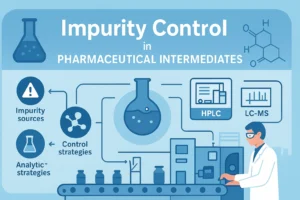Understanding Side Effects of Posaconazole
What is Posaconazole and How Does it Work?
For patients who frequently use posaconazole, it is crucial to understand its side effects and working mechanism. As a professional manufacturer of pharmaceutical intermediates and APIs, today, we will systematically explain posaconazole.
Posaconazole is a broad-spectrum antifungal drug, a second-generation triazole drug derived from itraconazole. It was launched in the US Food and Drug Administration (FDA) in 2006 under the trade name NOXAFIL. Posaconazole can interfere with the formation and function of fungal cell membranes, thereby achieving antibacterial effects.
Specifically, it works mainly in the following ways:
Main method | How it works |
Inhibits fungal cell membrane synthesis | Posaconazole can inhibit the synthesis of cholesterol in fungal cell walls, thereby preventing the synthesis of fungal cell membranes, destroying their integrity, and leading to fungal cell death. |
Interference with bacterial cell wall synthesis or nucleic acid metabolism: | Posaconazole can also interfere with bacterial cell wall synthesis or nucleic acid metabolism, further exerting its antibacterial activity. |
Blocking viral replication | Posaconazole can block key steps in the viral replication cycle, thereby inhibiting viral reproduction. |
Immunomodulation | Posaconazole has a certain immunomodulatory effect, which can enhance the body’s immunity, but it also affects the body’s immune system. |
Inhibition of cell proliferation | Posaconazole can interfere with the function of fungal cell cycle regulatory proteins, preventing them from entering the division phase, thereby controlling the number of fungal cells. |
Why Does Posaconazole Have Side Effects?
The main reason why posaconazole has side effects is that as an antifungal drug, while inhibiting the synthesis of fungal cell walls, it may also have a certain impact on the body’s normal physiological activities, especially those cells with similar structures to fungal cells, such as liver cells, etc. In addition, different patients have different physical conditions, metabolic capacity and sensitivity to drugs. These factors may cause patients to respond differently to posaconazole, resulting in different side effects.
Common Side Effects of Posaconazole Treatment
Both patients and medical workers should pay great attention to the common side effects of drugs and take timely measures to monitor and treat them to ensure the safety and effectiveness of drug treatment.
Gastrointestinal Side Effects of Posaconazole
The gastrointestinal side effects of posaconazole are a common adverse reaction during its use. These side effects usually manifest as gastrointestinal discomfort symptoms such as nausea, vomiting, diarrhea, and abdominal pain.
Cause
As an antifungal drug, posaconazole may also have a certain effect on the body’s normal cells, especially gastrointestinal cells, while inhibiting the synthesis of fungal cell walls. The drug may change the normal flora of the gastrointestinal tract and interfere with its normal function, thereby causing gastrointestinal discomfort.
Skin Reactions and Other Common Side Effects
In addition to gastrointestinal side effects, posaconazole may also cause skin reactions and some other common side effects during use. The following is a detailed summary of these side effects:
Skin reactions
Rash: Posaconazole may cause allergic reactions or drug-induced rashes, which appear as red spots, papules or plaques on the skin, accompanied by itching or discomfort.
Itching: Some patients may experience systemic or local skin itching after using posaconazole.
Redness and swelling: The skin may become red and swollen, especially in areas that come into contact with the drug.
Skin peeling: In rare cases, severe skin reactions may cause skin peeling.
Long-term Side Effects of Posaconazole
Gastrointestinal risks: Gastrointestinal discomfort + Gastrointestinal inflammation
Hepatic risks: Abnormal liver function + Hepatotoxicity
Renal risks: Renal impairment + Drug accumulation
Resistance risks: Resistant fungal infection + Treatment failure
Other risks: Drug interactions + Withdrawal syndrome
QT interval prolongation: Posaconazole may cause QT interval prolongation and increase the risk of arrhythmias. Long-term use may further increase this risk.
Reducing the risk of serious side effects of posaconazole requires the joint efforts of patients and doctors. Through strict indication selection, individualized dosage management, monitoring of drug interactions, regular monitoring and follow-up, attention to lifestyle and dietary adjustments, as well as education and guidance, the risk of side effects of posaconazole can be minimized to the greatest extent possible to ensure the safety of patients’ medication.
Conclusion
As an API manufacturer dedicated to advancing safe and effective drug use, we encourage everyone to stay informed about the side effects of medications like posaconazole. Understanding and managing these effects can help ensure a safer treatment experience and promote long-term health. Always consult healthcare providers for guidance on safe medication use, and be mindful of potential risks.
Our team of experts is committed to providing high-quality pharmaceutical ingredients and support for all your needs. If you have any questions or require assistance, please feel free to reach out to our professional team for a consultation. We’re here to help you navigate the path to safe and effective medication use. Stay informed, stay safe, and prioritize your health!



